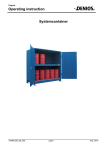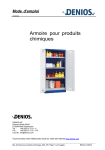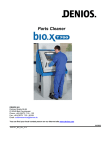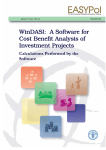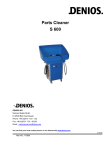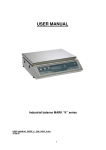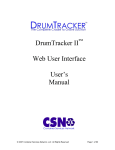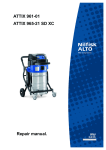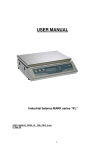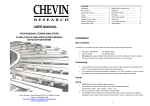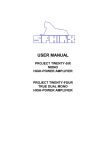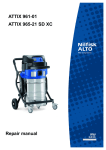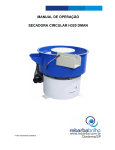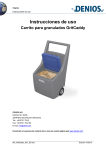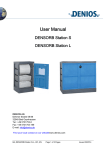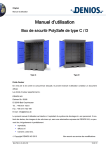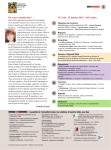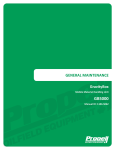Download Operating instruction
Transcript
Original Operating instruction page 1 Table of contents 1 General Instructions ........................................................................................................................................... 3 1.1 1.3. Legend, Explanation of symbols ............................................................................................................. 3 1.2 Basic safety instructions ................................................................................................................................ 4 2 Safety instructions .............................................................................................................................................. 4 3 Intended use....................................................................................................................................................... 5 4 Product description............................................................................................................................................. 7 4.1 Design ............................................................................................................................................................ 7 4.2 Technical Data ............................................................................................................................................... 8 5 Transport ..........................................................................................................................................................10 5.1 Transport securing devices and handling by crane .....................................................................................10 5.2 Transport by fork-lift truck ............................................................................................................................11 6 Erection / Commissioning.................................................................................................................................11 6.1 Erection conditions.......................................................................................................................................11 6.2 Additional conditions for the storage of flammable substances outdoors....................................................11 6.3 Alignment and anchoring in the ground .......................................................................................................12 6.4 Earthing........................................................................................................................................................17 7 Operation..........................................................................................................................................................18 8 Malfunctions .....................................................................................................................................................18 9 Maintenance and Repair ..................................................................................................................................19 10 Putting out of operation ....................................................................................................................................19 11 Disposal............................................................................................................................................................19 11.1 Certificate supervision contract ...............................................................................................................21 11.2 Certificate SLV.........................................................................................................................................22 11.3 Control- and maintenance-plan ...............................................................................................................24 page 2 1 General Instructions 1.1 1.3. Legend, Explanation of symbols The following safety symbols are used in these operating instructions. Above all, these symbols are intended to draw the attention of the reader to the adjacent safety instructions. This symbol indicates that there are hazards to the life and health of persons. The symbol indicates that there are hazards for the machine, material or environment. This symbol identifies information provided to improve understanding of the product and correct handling of the product. This symbol warns of dangerous electrical voltage within the working area (e.g. electrical distributors, terminal boxes, etc.) This symbol warns of hazards caused by explosive atmospheres. This symbol indicates suspended loads and their concomitant dangers. This symbol indicates a possible risk of crushing This symbol indicates a possible risk of crushing body parts (especially hands) by moving machine parts or machine parts that are closing. SEPARATE INSTRUCTIO NS This point refers to additional operating instructions or regulations (enclosed or delivered separately) required for operation or maintenance of accessories; these must be read and carefully observed. (safety instructions referring to these must always be observed). page 3 1.2 Basic safety instructions Keep this user manual in a safe place. It has been designed for practical use and should be available to the user on site. This user manual applies to the . It contains all the information needed regarding correct startup, trouble-free operation, maintenance, removal from service and disposal. The instructions in this user manual must be carefully followed and adhered to. Any person who is involved in the installation, use, servicing or repair of the product is required to have familiarized him/herself with the contents of the user manual and to have been trained and instructed in its handling. These instructions for use do not absolve the operator from the duty to issue special operating instructions in accordance to the German GefStoffV and BetrSichV (hazardous substances regulation and the regulation for industrial health and safety). The user manual us based on the safety data sheet and a risk assessment. The prohibition regarding the storing together of certain substances must be adhered to. No changes, extensions or modifications may be made to the product without the manufacturer's written authorisation. National regulations and safety regulations have to be adhered to. 2 Safety instructions The storage system may only be operated by skilled and instructed personnel. Potential hazards have to be identified. Unauthorized people are not allowed to enter the storage system. The storage system may only be used for its intended purpose. Handling of hazardous substances is only allowed while wearing the specified protective equipment. If the storage system is damaged, it has to be repaired immediately by an approved company while observing the required safety measures. In case of any damage the storage system must be put out of service. There is the risk of bruises when using the door. page 4 Only store materials for which the storage is designed. The trading units for the materials must comply with the provisions for the Transportation of Dangerous Goods. The trading units may only be opened for filling and emptying. They are only allowed to be dispensed above the sump. The following regulations and instructions, latest issues, have to be observed: - BGV A1 and BGR 234 - The information leaflet “Rules of operation and conduct for the storage of water-hazardous liquids" (put it up at a clearly visible position!) - Construction supervision approval (if available) Fire, naked flames or smoking are not allowed. The system has to be checked regularly. For this purpose, refer to the Control and Maintenance Plan 3 Intended use The is a storage system used to store hazardous substances and flammable liquids of the classes R10, R11 and R12 in accordance with the ordinance on hazardous substances (later than 01 December 2010, these classes will be called H 224, H 225 and H 226 acc. to GHS). The specified total volumes of the storage system must not be exceeded. The load capacity of the storage system in the data sheet/on the type plate must also be observed. Make sure that the substances are only stored on the grids. During storage, the total permissible storage volumes as well as the maximum permissible storage volume of the largest storage unit must be met and observed, depending on the provided sump capacity. Additionally, before use and after any change of the type of the stored media, it will be necessary to prove that the material of the sump is resistant to the medium to be stored. This proof can be provided: - by DIN 6601 or - by the BAM list - as a proof of experience Drums may only be placed into the storage system or removed from it, or lifted down, using suitable equipment (e.g. drum grippers). page 5 Substances are only permitted to be stored together when the risk assessment indicates that there are no hazards caused by possible reactions or physical influences. Otherwise, the substances must be stored separately. The substances must be stored in a way that all trade units and the sump can be viewed. Packagings and trading units must comply with the provisions for the transportation of dangerous goods. page 6 4 Product description 4.1 Design The Basic Store containers are designed as follows: - Frame structure made of rolled box sections according to structural analysis. Side walls made of galvanized steel sheets Rear panels and roof made of galvanized trapezoidal sheet sections Sump made of steel (material S235 JR, material number: 1.0038 according to DIN EN 10025-2) and tested using a leak test according to DIN EN-571-1 Optional sump insert made of plastics (PE HD) Optionally, depending of the type, the front can be equipped with wing door or sliding door. The electrical earth connection of the basic body is ensured. The surface of the basic body is one-colour painted on a 2K-PUR basis. Doors are made of galvanised steel sheets. Foot plates are mounted to fix it to the bottom. Model codes BS 60-2D-ST V600 (Example) BS 60 - 2 D - ST V600 V600 Sump capacity 600 l 1200 l 2000 l ST Door element ST = Sliding door TE = Wing door D Stock type (preferred) D = Storage of drums K = Storage of CTCs (IBCs) 2 60 BS Number of storage levels 1 or 2 One-bay container 30 Two-bay container 60 Container model Basic Store page 7 page 8 mm l Height (H) Sump capacity - net Shelf load mm Depth (D) kg l mm Width (W) gross mm Shelf height (SH) 1250 3591 2000 2200 3171 1200 1370 600 730 1340 2 3001 2 2 16 V2000 BS 30-2D 3500 1660 2830 1340 2700 1370 1200 3001 2430 1 8 2 V1200 BS 30-1K 1370 1200 3571 1450 2 4 V1200 BS 30-2K 2200 2000 3591 1340 2 4 V2000 BS 30-2K Basic Store – One-bay container mm 16 V1200 V600 16 BS 30-2D BS 30-2D Basic Store – One-bay container 4.2.1 Shelf depth (SD) mm Drums CTC Unit Technical Data Shelf width (SW) Number of storage levels Storage capacity Image Data 4.2 page 9 mm mm l Depth (D) Height (H) Sump capacity - net Shelf load mm Width (W) kg l mm Shelf height (SH) gross mm mm Drums CTC Unit Shelf depth (SD) Shelf width (SW) Number of storage levels Storage capacity Image Data 1250 3171 2x 1200 2x 1370 2x 600 2x 730 2 2 3001 32 V 2x1200 V 2x600 32 BS 60-2D BS 60-2D 2x 2200 2x 2000 3591 1340 2 32 V 2x2000 BS 60-2D 3500 1660 5650 1340 2700 2x 1370 2x 1200 3001 2430 1 4 V 2x1200 BS 60-1K Basic Store – Two-bay container 2x 1370 2x 1200 3571 1450 2 8 V 2x1200 BS 60-2K 2x 2200 2x 2000 3591 1340 2 8 V 2x2000 BS 60-2K 4.2.2 Basic Store – Two-bay container There are proofs of stability available for the Basic Store which are based on the following load assumptions: Load assumptions: 5 Wind load: 0.39 kN/m2according to DIN 1055 Snow load: 1.25 kN/m2according to DIN 1055 Transport Before transport, make sure that the permissible total height and width are not exceeded. 5.1 Transport securing devices and handling by crane Only empty Basic Stores are allowed to be transported! Before starting transport activities, fasten the container on the specified lashing points. To transport the Basic Stores with crane eyes, the lifting angle of the ropes may not exceed 60°. Refer to the image "Lashing of ropes/chains". Container models: BS - one-bay Container models: BS - two-bay Image: Lashing of ropes/chains page 10 5.2 Transport by fork-lift truck Basic-Stores may only be unloaded and transported with fork-lift trucks of sufficient load capacity. Make sure that the forks are long enough to avoid tipping over. Consider the maximum load capacity of the fork lift! 6 Erection / Commissioning 6.1 Erection conditions Basic Stores may only be placed on even and paved surfaces. The foundation provided by the customer must be able to discharge the indicated loads. The selection of concrete with regard to load capacity, fitness for use and durability compliant to DIN EN 206 must be determined by the planner in accordance with the local requirements (refer also to the foundation plan). It may be required that an expert or a specialist firm has to prove the system before the commissioning. 6.2 Additional conditions for the storage of flammable substances outdoors. For the erection of Basic Stores, the following installation instructions (refer to images 1 - 3) have to be observed and kept to ensure the natural ventilation: Safety distances to the adjacent buildings have to be kept and protecting strips must be established. Flammable materials may only be stored passively in naturally ventilated Basic-Stores. Image 1 Formation of blocks with max. 4 containers; 2 pieces each, in 2 rows after another page 11 Image 2 Containers in a row without limitation of piece number! Image 3 2 containers placed next to each other in a row against a wall! 6.3 Alignment and anchoring in the ground 1. The container is set up at the desired place. To be able to reach the rear fixing points, a distance of 60 cm should be kept to buildings and the other facilities. 2. Remove the transport securing devices of the doors. In case of wing doors, they are in the middle - at the bottom. In case of sliding doors, each sliding door element is secured outside, at the bottom, and additionally outside, at the top. Wing door - transport securing device (front view) Wing door - transport securing device (side view) page 12 Sliding door - transport securing device (at the bottom) Sliding door - transport securing device (at the top) 3. The container has to be aligned horizontally and vertically using a spirit level. Also ensure that the doors are in alignment. Image: Correct position of the door alignment marks For the alignment use shims which are laid under the foot plates. 4. After the container has been aligned, the dowel boreholes are to be drilled. Please find the required boreholes in the images below. page 13 In case of the sliding doors, the middle door guide has to be removed to get access to the borehole. It must be reinstalled after the dowel has been inserted. Sliding door - middle door guide Position and number of composite anchors, refer to Images 1 - 2: Image 1 Basic Store - One-bay containers Number of composite anchors: 4 page 14 Image 2 Basic Store - Two-bay container Number of composite anchors: 6 5. Apply the dowels according to the manufacturer's instructions. Attach locking nut and washer and fasten the nut. 1 1 Down comer - container 2 Foot plate 3 Fixing nut M16 4 Washer 5 Composite anchor M16 with anchor cartridge 2 3 4 5 Image: Detail of floor anchor with foot plate page 15 6.4 Earthing For the storage of flammable substances, Basic Stores have to be connected to earth (refer to image). To do this, use the VbF accessory kit (item no.: 138099). The earth conductor at the customer's side is to be connected to the VbF accessory kit. You can also connect round or flat steel earth connections. Connection with flat steel earthing conductor Connection with round steel earthing conductor Side view of earthing connection page 16 7 Operation • • Open the doors for loading or unloading the stored goods. Secure the wing doors using the storm hooks. In case of sliding doors make sure that no objects are in the closing edge when closing the door. Use a suitable lifting gear (e.g. fork lift truck with drum grippers) to place the containers on the grid or to unload them. When storing metal containers place them carefully on the grid (speed 1 m/s) to prevent any possible sparks. During storage or removal, the trading units must be secured against tipping over. For transport, also secure the trading units against tipping over. When loading/unloading, pay attention to the shelf depth (refer to the Technical Data). • Store the goods that way that the sump can always checked visually from one position. • After the storage system has been used, close the doors immediately. • Lock the doors to avoid unauthorized access. • Observe the safety instructions. • Remove inadmissible snow loads from the storage system. • • • • 8 Malfunctions Error Cause Action Liquid in the sump Rainwater Get the storage system sealed. Dispose the liquid from the sump without damaging the environment. Leaky container Dispose the liquid from the sump without damaging the environment. Check the sump for damages. Bent grid Load too high Replace the grid. Check the storage system for damages. Doors are difficult to move Hinges, rolling elements Lubricate the components. If it does not become better, replace the components. For questions or repairs contact our Denios specialists. page 17 9 Maintenance and Repair Switch the power supply off (if it exists) before starting maintenance and repair works and secure it against accidental switching on by taking appropriate measures. • Please find hints for maintenance and repair in the Control and Maintenance Plan attached to these operating instructions. • We recommend ordering a yearly maintenance service by the DENIOS AG. • Before performing the maintenance or repair works, cut off the access to the storage system for unauthorized people! Post or place an information sign which informs about the maintenance and repair works! • When exchanging parts use only original replacement parts from the manufacturer! 10 Putting out of operation If the storage system is damaged it has to be put out of service and labelled accordingly. 11 Disposal The container is comprised of various components and parts which must be disposed or or recycled in compliance to the local and legal regulations. Before the disposal, any hazardous residue must be thoroughly cleaned off from the container! Disassemble or dismount the single components of the container and arrange the components into the following groups • Steel • Light metals • Non-ferrous heavy metal • Plastic • Electronic components and cable • Building materials/insulation material Ensure that all of these components are disposed of correctly and professionally, and are thereby a part of the recovered substance cycle. page 18 11.1 Certificate supervision contract page 19 11.2 Certificate SLV page 20 page 21 11.3 Control- and maintenance-plan page 22 page 23























